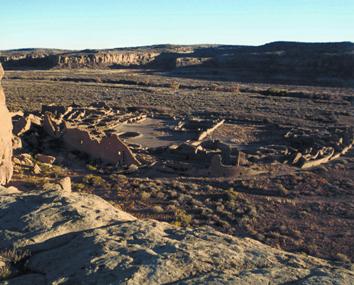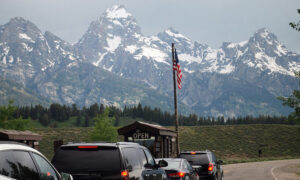
By G.B. Cornucopia, park ranger, Chaco Culture National Historical Park

Let’s be honest, Chaco Canyon, in northwestern New Mexico, is difficult to access. The two roads leading into the area, one from the north, and one from the south, are rough dirt roads.
Beyond these roads, the adventurous traveler will find a world little dreamed of when Europeans first came to this continent.
The Spaniards dreamed of cities of gold as they moved into the “New World,” not suspecting that long before they arrived, even before Columbus set sail, a civilization had already come and gone, leaving behind hundreds of large expansive buildings. This ancient site came to be known as “Chaco” and was centered in the canyon of that name. Now a World Heritage site, Chaco Culture National Historical Park remains accessible to the tens of thousands of visitors a year who are willing to make the journey.
Chaco Culture is impressive to even the most seasoned adventurers. More than a dozen sandstone brick buildings, some four stories high with hundreds of rooms, were constructed, along with storehouses of rich material goods, such as pottery, turquoise, weavings, shells, ceremonial items, plus all the goods needed for daily living. This just in the canyon itself!
In the 1970s and 80s a survey of this ancient world revealed that it encompassed 60,000 to 70,000 square miles. It was held together by roads and communication systems that took advantage of high points on the landscape, allowing the Chaco influence to be felt far and wide. This all took place in a landscape of semi-arid high desert with unpredictable rainfall, searing heat in summer, and deadly cold in winter.
Since 1896, when the first excavation began in the largest of the buildings in the canyon, researchers, scholars, and theorists of all kinds have attempted to explain the Chaco phenomenon. Books, journals, magazines, television documentaries, and even novels have presented myriad stories speculating what Chaco was all about.
This we know: between 850 CE (common era) and 1150 CE, several diverse groups worked together on ambitious projects of construction and organized activities that ruled throughout the Four Corners area of the southwest, taking advantage of good rainfall when it came, becoming resilient in times of drought. These people maintained a vision that carried them through prosperity and success, until a final drought caused them to scatter, leaving behind all the unanswered questions confronting us today.
Today, visitors can walk through the buildings in the canyon, either on their own, or on the many guided walks led by park rangers. They can explore four backcountry trails on the mesa tops, or stroll along panels of petroglyphs and pictographs and ponder the handiwork of the ancient ones.
Visitors can attend one of the many evening programs in the campground or under the stars at Chaco’s observatory that takes advantage of one of the darkest night skies imaginable.
A full understanding of the Chaco world has yet to be constructed. Not knowing is its own kind of inspiration. But one leaves Chaco with the haunting realization that our modern world, for all its inventiveness, is not the first to try its hand at large-scale unification of disparate groups of people.
Remote and isolated, Chaco Culture National Historical Park offers few amenities, so come prepared. You’ll find that the rewards are unlimited.
Camping at Chaco Culture National Historical Park
Gallo Campground
Open
Open All Year.

Gallo Campground, located one mile east of the Visitor Center, is open year-round. Tucked among the fallen boulders and cliffs of Gallo Wash, the campground offers camping in a rugged environment, surrounded by petroglyphs, a cliff dwelling, inscriptions, and a high desert landscape. There is no shade. The campsites are available on a first-come, first-served basis. Camping is limited to 14 days. Each campsite costs $10.00 per night. Interagency Senior pass holders pay $5.00 per site, per night. There is a limit of six people, two tents, and two vehicles at each campsite. Check-out time is 11:00AM.
Each site has a picnic table and fire grate (with a grill). Bring your own firewood or charcoal. Gathering wood is prohibited and no firewood is available in the park. Most sites include a tent pad. Pets are permitted, but must be kept on a leash at all times. Do not approach or feed the wildlife. The campground has water (non-potable) and restrooms with flush toilets. Site #16 and both restrooms are handicap accessible. There are no showers or hook-ups. Drinking water is available 24 hours a day in the Visitor Center parking area. There is no gasoline, auto repair, food, or ice available in the park. To make the most of your visit, please plan ahead and come prepared.
Sites 35-49 are reserved for tent camping only. Most of the other sites are open to RVs or tents. Car camping is allowed.
RV Information
Trailers and RVs over 35 feet in length cannot be accommodated. There are no hook-ups. A dump station is located in the campground. Generators may be operated one hour at a time between 8:00AM and 8:00PM.
Get more information about Chaco Culture National Historical Park at the Park’s Website






